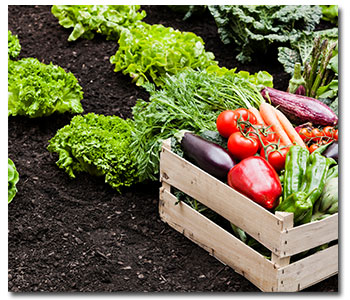10 Steps to Growing a Productive Vegetable Garden

Few gardening endeavors are as enjoyable or rewarding as growing your own vegetables. The pure pleasure of strolling through your garden as you harvest tomatoes, beans, cucumbers and the like for that day’s meal is only heightened by the knowledge that you’re experiencing the freshest, most flavorful and nutritious produce nature can create.
Growing vegetables isn’t all that different from other types of gardening. However, there is less room for mistakes. Successful vegetable gardening is about consistency – making sure growing conditions are properly maintained for the entire growing season. Let plants go dry just for a little while, or forget to fertilize, and you may sacrifice a large portion of your harvest.
Follow these 10 steps to help you enjoy the bounty of a productive vegetable garden:
1. Choose locally adapted varieties. Not all vegetable varieties grow well in all areas. Ask your local nursery or cooperative extension office which varieties are best for where you live. There may be varieties that resist diseases specific to your area, or that produce better crops under your climate conditions.
2. Plant at the right time of year. Seed packets generally state the proper time to plant. In some areas planting windows are very narrow and you must hit them fairly precisely for a bountiful harvest. In other areas, you can plant several times over the summer and maintain a longer harvest season. Your local nursery or cooperative extension office is the best source for local planting dates. See our vegetable planting guide.
3. Prepare the soil properly before planting. Work in generous amounts of organic matter such as compost or composted manure. If you don’t use composted manure, which already contains nitrogen, also work in a complete fertilizer.
4. Plant properly. Sow seed at the proper depth and space, following directions on seed packets. Vegetables planted too closely together will produce poorly. If you’re planting transplants, take care not to set them too deeply or the stems may rot – use your trowel to dig a hole just deep enough so that the top of the root ball is level with the surface of the ground.
5. Water consistently. Maintain even soil moisture so plants do not dry out, but don’t over-water. Water deeply, then give the soil time to dry partially before watering again. Inconsistent watering will reduce yields in most vegetables, and make others – like cucumbers and lettuce – taste bitter. Installing a drip irrigation system connected to an automatic timer is your best bet.
6. Fertilize regularly. Maintaining vigorous growth is very important with almost all vegetables. Most should be fed with a nitrogen fertilizer at least every 4 to 6 weeks. However, be careful not to over-fertilize, which can cause some vegetables, especially tomatoes, to produce less.
7. Mulch. A 2- to 3-inch layer of organic matter applied over the roots of your vegetable plants will cool the soil, reduce weeds, and help prevent soil moisture fluctuations that ruin quality.
8. Eliminate weeds. Weeds compete with vegetables for water, nutrients and sunlight, thus reducing yields. Pull weeds by hand and cultivate the soil frequently to keep them to a minimum.
9. Harvest often. Many vegetables, especially beans, squash, peppers and cucumbers, will stop producing if not harvested frequently. Pick every few days. If you can’t eat all you gather, share with friends or neighbors.
10. Control insect pests. Many insects enjoy fresh vegetables as much as you do. Always keep an eye open for insect damage, and protect your plants with a solution labeled for use on vegetables.
Article Courtesy of Bayer Advanced











